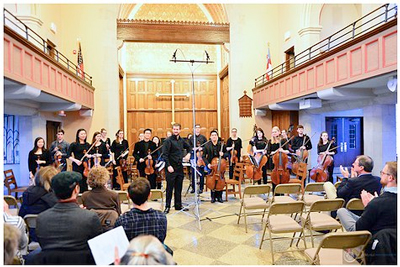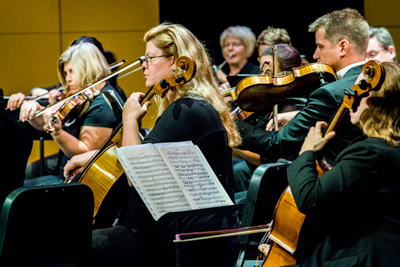by Mike Telin

The highlight of the concert was the Concerto for Piano, Violin, and Strings in d, in no small part due to the brilliant playing of violinist Solomon Liang and pianist Megan-Geoffrey Prins. While still in their formative years, the two soloists performed with a musical sophistication to their performance that many musicians can only hope to achieve. Individually they brought a rich, clear sound to their lines, and played collaboratively from a single mind during the long first movement, which includes an odd recitative section. After a beautiful “Adagio,” Liang and Prins were off in a flash for the final “Allegro molto,” bringing the concerto to an exciting conclusion. Ellis kept the communication lines between the soloists and orchestra keenly in-check, and the large audience rewarded the performers with an enthusiastic ovation.
Ellis opened his young ensemble’s second season with a spirited performance of the Symphony No. 2 in D. He drew a rich sound from the eleven players during the opening “Allegro,” while a lovely blend and attention to phrasing defined the “Andante.” Setting a brisk tempo, which he maintained throughout the concluding “Allegro vivace,” Ellis brought the work to a satisfying end.
The Symphony No. 12 in g, the last of the Mendelssohn’s “youthful” symphonies, finds the composer experimenting with fugue in the opening movement. The crisp, dotted articulations of the Grave transitioned beautifully into the Allegro. Here the counterpoint presented some brief ensemble problems, although Ellis and his players quickly settled into the complex musical lines. The slow movement revealed the composer’s natural ability to write “songs without words,” and the galloping “Allegro molto” ended the engaging piece.
BlueWater Chamber Orchestra

William Grant Still’s Danzas de Panama is a delightful, four-movement work that draws on music with Caribbean-African and Spanish-Indian origins. The Orchestra produced a lush sound during the lyrical “Mejorana y Socavon” and “Punto,” and the concluding “Cumbia y Congo” was full of exuberance.
It was during George Walker’s Lyric for Strings that Sustaita and the players were at their best. The combination of the warm Pilgrim acoustics and the richly hued performance resulted in a listening experience that was mesmerizing.
The 60-minute concert concluded with an exciting, if sometimes breathless, interpretation of Bartók’s Divertimento for Strings. Producing a full-bodied sound, the BlueWater musicians tossed off the work’s many intricate rhythmic challenges with ease. Sustaita kept dynamic balances under control throughout, allowing for the many solos to be clearly heard. Kudos to violinists Ken Johnston and Emily Cornelius, violist Laura Shuster, cellist Kent Collier, and bassist Ann Gilbert for their outstanding work. The audience showed their appreciation for the concert with a hearty ovation.
Published on ClevelandClassical.com November 29, 2016.
Click here for a printable copy of this article



